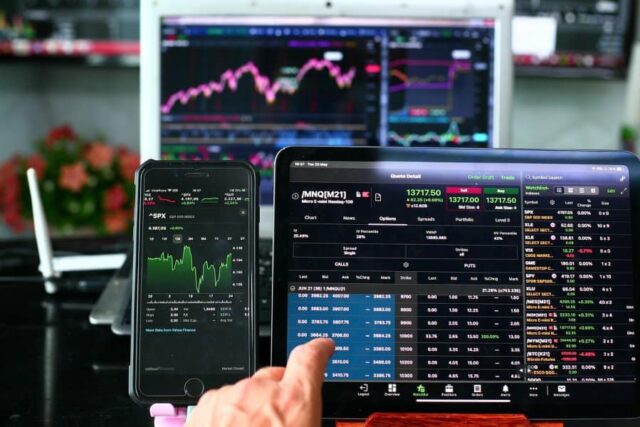NASDAQ futures trading has become an integral part of the modern financial landscape. The ability to understand and leverage nasdaq futures live data can make or break investors. Diving into this volatile market segment has its advantages and disadvantages.
The NASDAQ Stock Market
The NASDAQ, founded in 1971, stands as the second-largest stock exchange in the world by market capitalization. Unlike traditional stock exchanges, it started as an electronic-based system, revolutionizing the trading world.
Role of NASDAQ in Financial Markets
NASDAQ plays a crucial role in the global financial markets, housing giants like Apple, Microsoft, and Amazon. Its influence extends beyond just hosting companies; it’s a benchmark for tech-heavy portfolios and the health of the tech sector.
NASDAQ vs. Other Stock Exchanges
While both NYSE and NASDAQ are leading exchanges, they differ significantly. NYSE has a physical trading floor, whereas NASDAQ is entirely electronic. Furthermore, NASDAQ typically lists more tech-oriented companies, setting a unique tone in terms of volatility and growth potential.
Futures Contracts Demystified
Futures contracts are standardized agreements to buy or sell an asset, like NASDAQ indexes, at a predetermined price on a set future date. They provide a mechanism to hedge or speculate on the price movement.
Why Trade NASDAQ Futures?
Trading NASDAQ futures allows investors to capitalize on price movements without owning the underlying assets. They provide flexibility, potentially high returns, and the ability to short, allowing profits in declining markets.
Risks Associated with Futures Contracts
Futures trading is not without risks. The leverage employed can amplify both gains and losses. Moreover, due to the contract’s time-bound nature, it’s crucial to monitor NASDAQ futures live and adjust strategies swiftly.
NASDAQ Futures Trading Mechanics
NASDAQ futures operate like other futures contracts but are based on the NASDAQ Composite Index. When traders buy a futures contract, they agree to purchase the index at a specified price on a future date. Conversely, selling a contract means agreeing to sell the index at a predetermined price. These contracts standardize and simplify the process, allowing traders to forecast price movements.
Trading Hours and Trading Platforms
NASDAQ futures markets operate nearly 24 hours a day. Trading platforms vary, but most offer:
- Real-time data and analytics
- Automated trading options
- Customizable interfaces for efficient execution
Market Participants in NASDAQ Futures
In the NASDAQ futures arena, you’ll find various players. Institutional investors, like hedge funds, often use futures to hedge their portfolios. Individual traders, on the other hand, might seek opportunities for short-term profits. Both types contribute to market liquidity and dynamics.
Risk Management in NASDAQ Futures Trading
Stop-loss orders automatically sell a position if its price drops to a predetermined level. It’s an essential tool for limiting potential losses, especially in the fast-paced environment of futures trading.
Position Sizing and Leverage
Strategic position sizing entails the meticulous allocation of your portfolio to specific trades, ensuring diversification. NASDAQ futures traders can also harness the power of leverage, enabling them to command a larger position with a comparatively modest capital infusion. Nevertheless, it’s crucial to comprehend that while leverage magnifies potential gains, it concurrently amplifies the specter of losses.
Diversification Strategies
One of the main components of risk reduction is diversification. It entails the prudent distribution of investments over a variety of assets or asset types. There are several ways that diversity might appear for traders of NASDAQ futures. It might involve entering new futures markets or finding a careful balance between traditional stocks, bonds, and alternative investments and futures. This multifaceted strategy offers a strong barrier against being overexposed to a particular asset class or market niche.
Pros and Cons of NASDAQ Futures Trading
Before delving into its nuances, let’s look at the advantages and disadvantages of trading NASDAQ futures to provide potential traders with a complete picture.
Benefits:
- Liquidity: NASDAQ futures markets boast exceptional liquidity, ensuring swift execution of trades.
- Flexibility: Traders can choose to take long or short positions, which allows them to benefit in both bull and downturn markets.
- Hedging Opportunities: NASDAQ futures trading is a useful way for investors to protect their portfolios from the risks associated with stock market downturns by hedging against unfavorable market movements.
Drawbacks:
- Leverage Risks: Although leverage increases earnings, it also puts traders at risk and can result in significant losses.
- Complexity: Gaining success in futures trading requires a deep comprehension of market dynamics as well as strategic acumen, which presents a challenging learning curve for novices.
- Short-Term Focus: Because NASDAQ futures are sometimes time-sensitive, traders must adopt a short-term viewpoint, which can be mentally exhausting for certain people.
Keeping Up with Market Trends
- Sustainable Investing: The NASDAQ Composite Index may be significantly impacted by the growing focus on sustainability and environmental issues. Businesses that put sustainability first may have a big effect on market dynamics.
- Tech Advancements: Blockchain technology, the Internet of Things (IoT), and artificial intelligence (AI) innovations might make or break tech-heavy NASDAQ listings. Making educated decisions requires staying up to date with these technical developments.
In the dynamic world of NASDAQ futures trading, alertness, adaptability, and a well-thought-out risk management strategy are your allies as you maneuver through the intricate maze of opportunities and challenges.
Truth About Actual NASDAQ Futures Trading
The wide and dangerous world of trading NASDAQ futures offers plenty of chances to make money. The creation of trading strategies is heavily impacted by market dynamics, technology developments, and worldwide trends. Trader confidence in navigating this terrain will increase if they are aware of the nuances of NASDAQ futures and stay current with market movements. Risk management and ongoing education are crucial, just like with any investment. This essay’s goal is to arm aspiring traders with fundamental information so they can navigate the complex world of futures trading with expertise.














